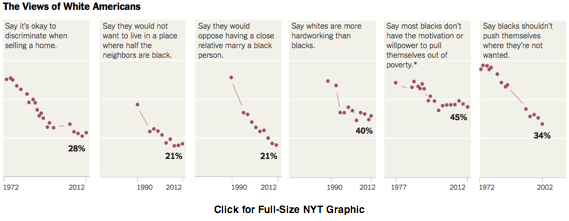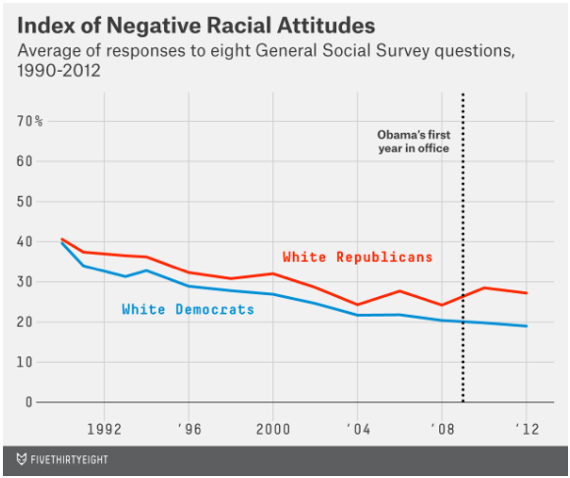
Another day, another national poll showing a bleak political environment for Democrats, yet with a different story about Obama's approval rating. The Upshot and FiveThirtyEight both tackle measurements of racial stereotypies. And when it comes to click bait, it's hard to top 'I Don't Agree With Nate Silver.' This is HuffPollster for Wednesday, April 30, 2014.
POLL FINDS OBAMA'S NUMBERS RETURNING TO STATUS QUO - Chuck Todd, Mark Murray and Carrie Dann: "Bill McInturff, the Republican half of our NBC/WSJ poll, perhaps summed up our latest survey the best: The poll shows that things are better for President Obama and the Democrats after eight million Americans enrolled on the health-care exchanges. But they are still far from good. Obama’s job-approval rating now stands at 44%, a three-point increase from last month, though that movement falls within the poll’s margin of error. For the first time since early October (before the federal health-care website’s disastrous launch became a months-long national story) the president’s personal favorable/unfavorable rating is right-side up, at 44% positive and 41% negative. And 36% see the health-care law as a good idea, versus 46% who view it as a bad idea -- a slight uptick from 35% good idea and 49% bad idea back in March. Bottom line: Obama’s standing is pretty much back to where it was BEFORE the website woes. But remember, that same standing was already difficult terrain for the president and Democrats. "
[NBC]
Better isn't the same as good - John Harwood: "'The president has moved from a wipeout position to a competitively negative position,' said Democratic pollster Peter Hart, who helps conduct the NBC/WSJ poll. But as his Republican counterpart Bill McInturff added, 'better' is not the same as 'good.'" [CNBC]
Agreement with Obama's economic message - Reid Epstein: "Yet, those polled agree with Obama’s overarching economic message that it has become harder for lower- and middle-class people to get a fair deal. More than half, 55%, said the country’s economic and political systems are stacked against them, the most that have said so in WSJ/NBC surveys since 1992. Dissatisfaction ranges over many political and economic institutions. Some 54% said the gap between rich and poor means not everyone has an opportunity to improve his or her standard of living. Confidence in the federal government is anemic (with only 16% saying they have confidence). The same goes for large corporations (13%), big banks (13%), the news media (19%) and health insurance companies (13%)." [WSJ]
Little appetite for foreign intervention - HuffPollster: "Forty-seven percent of Americans say the U.S. should be less active in world affairs, while 30 percent think it should remain at its current level. Just 19 percent want to see the country become more involved. hose opinions represent a stark change from just after the 9/11 attacks. In September 2001, 37 percent of Americans thought the country should be more active, and only 14 percent wanted it to take a less active role. While the NBC/WSJ poll hasn't asked the same question in the intervening years,other questions show similar support for an isolationist approach. **From 2005 to 2012, the percentage of of Americans saying the country should 'focus more on our own problems here at home' jumped 20 percentage points**, from 54 percent to 74 percent. CBS polls in the past two years found that a majority of Americans don't want the U.S. to take a leading role in solving conflicts." [HuffPost]
Remember yesterday's 'new low?' - Mark Mellman (D) does: "#overreadingpolls: yesterday ABC/WashPo Obama at approval low. WSJ/NBC today Obama gets bump. Can't be both true. Best bet: neither are" [@MarkMellman]
'WHY I DON'T AGREE WITH NATE SILVER' - Josh Kraushaar: "[C]ount me underwhelmed by the new wave of Senate prediction models assessing the probability of Republicans winning the upper chamber by one-tenth of a percentage point. It's not that the models aren't effective at what they're designed to do. It's that the methodology behind them is flawed. Unlike baseball, where the sample size runs in the thousands of at-bats or innings pitched, these models overemphasize a handful of early polls at the expense of on-the-ground intelligence on candidate quality. As Silver might put it, there's a lot of noise to the signal. The models also undervalue the big-picture indicators suggesting that 2014 is shaping up to be a wave election for Republicans, the type of environment where even seemingly safe incumbents can become endangered. Nearly every national poll, including Tuesday's ABC News/Washington Post survey, contains ominous news for Senate Democrats. President Obama's job approval is at an all-time low of 41 percent...Democrats hold only a 1-point lead on the generic ballot in the ABC/WaPo survey—worse positioning than before the GOP's 2010 landslide." [National Journal]
What's his beef? - Via Twitter conversation with HuffPollster, Kraushaar says his problem has less to do with the odds that Silver and the other modelers give of a Republican takeover, and more with the models themselves: "[I] think the model slow to capture a lot of on-ground developments, very reactive. dependent on flawed polling." He also argues that the models are too certain about the outcomes in the Senate races in Michigan, New Hampshire, Virginia and Oregon. How would he rate the probability of Democratic victories these states? "probably around 70% in MI; 55% in NH; 75% in VA, OR. Ballpark figures." Nate Silver's most recent update of his model rates the probability of victories as 55 percent in Michigan, 75 percent in New Hampshire, 90 percent in Oregon and 95 percent in Virginia. [@HotlineJosh via Storify, 538]
A Senate modeler reacts - John Sides, via Twitter: "Contra @HotlineJosh...@UpshotNYT's Senate model weights big picture more than early polls...Moreover, like our model [for the Washington Post], @UpshotNYT's model builds in information about 'candidate quality,' which @HotlineJosh cites as important. " [@monkeycageblog here and here, citing UpshotNYT]
Silver has no comment - Tom Kludt: "[Nate] Silver told TPM in an email that 'the results speak for themselves' and opted not to comment further." [TPM]
MEASURING RACIAL STEREOTYPES - Amanda Cox: "The condemnation of remarks by the Los Angeles Clippers owner Donald Sterling is almost unanimous. But racism is still more common than you may realize. In surveys, more than one-fifth of whites volunteer views consistent with negative racial stereotypes. While many fewer Americans express animosity toward blacks than they did 40 years ago, a CBS News poll from March showed that 46 percent of Americans thought racial discrimination would always exist." Cox produced a set of charts plotting responses to a of questions asked regularly over at least a dozen years by the General Social Survey. [NYTimes]
'Are White Republicans More Racist Than White Democrats?' - Nate Silver and Allison McCann combined eight GSS measures, including those captured by the NY Times graphic, into a combined index of negative racial attitudes: "We accomplished this by averaging the number of white Americans who provided the arguably racist response to each survey item, extrapolating the value for years in which the General Social Survey didn’t ask a particular question based on the long-term trend in responses to it. As of 2012, this index stood at 27 percent for white Republicans and 19 percent for white Democrats. So there’s a partisan gap, although not as large of one as some political commentators might assert. There are white racists in both parties. By most questions, they represent a minority of white voters in both parties. They probably represent a slightly larger minority of white Republicans than white Democrats. [538]
Measuring 'racism' isn't easy - David Hill (R) "From a pollster’s perspective, racism is a tough nut to crack. Is there any proven and tested battery of questions that will measure racism? For that matter, is racism a single construct, or is it a multidimensional phenomenon that renders measurement nigh impossible?...When race is an issue in campaigns, pollsters need to get their hands around its measurement. In races where I have needed to consider the role that racism plays in voter choice, I have struggled to get it right, usually settling on an indirect strategy of asking voters whether they knew other voters who were being influenced by race. My assumption, then as now, has been that voters will not fess up to direct questions about their own racism. They may not even be self-aware of their true feelings about race and how it might affect their electoral behavior." [The Hill]
RANKING SENATE RACES BY VOTER MOBILIZATION - The New Republic: "While pundits cite polls, the political pros who steer campaigns keep their eyes on different figures: how many actual votes their candidate needs to prevail, and where those votes will come from. Proprietary formulas reveal the number of votes that a contender can count on going in, which leaves a shortfall that can be closed through mobilization. With field studies having determined a price for each additional vote yielded by the most effective turnout tactics, we were able to compare the relative difficulty and costliness of this year’s most competitive Senate races….Of course, no campaign would ever rely solely on volunteer outreach or paid get-out-the-vote communications. But by calculating absolutes for both methods, we were able to compare the work ahead for Democrats in these races, and what it will take the party to hang onto or pick up the seat by transforming the midterm electorate through turnout." The top three races? West Virginia, Alaska and Montana. [TNR]
HUFFPOLLSTER VIA EMAIL! - You can receive this daily update every weekday via email! Just click here, enter your email address, and and click "sign up." That's all there is to it (and you can unsubscribe anytime).
WEDNESDAY'S 'OUTLIERS' - Links to the best of news at the intersection of polling, politics and political data:
-PPP (D) finds Tom Cotton and Mark Pryor tied in Arkansas. [PPP]
-ABC/Washington Post is the latest national poll to show a wide open Republican primary while Hillary Clinton dominates the Democrats. [WashPost]
-Presidential polls taken two years out almost never predict the winner. [NYT]
-Republicans may not think their candidates deserve reelection, but they plan to vote for them. [WashPost]
-The Harvard IOP survey provides another measurement showing college age Millennials to be less Democratic than their older counterparts, argues John Sides. [WashPost]
-Dante Chinni uses college towns to illustrate how turnout declines among younger voters in off-year elections. [WSJ]
-Jamelle Bouie cautions Republicans from reading too much into the gains they are likely to make in 2014. [Slate]
-Mark Mellman (D) reviews the "sound and fury" of criticism directed at last week's New York Times/Kaiser polls of four southern states and finds "no real evidence these polls are flawed." [The Hill]
-Andrew Kohut cautions Republicans about a strategy of attacking Obama's foreign policy. [Politico]
-An Edison Research exit poll in Iraq projects Nouri al-Maliki's State of Law Party to be the largest in the Parliament. [Edison Research]
-Harry Enten notes that "establishment Republicans" are poised to defeat "Conservative outsiders" in this years Senate primaries. [538]
-The former senior Facebook engineer who was hired to oversee the RNC's data and tech overhaul will be taking a diminished role at the committee. [HuffPost]
-Self-funding donors accounted for 27 percent of the money raised in 16 high dollar primary races this year. [WashPost]
-Global Strategy Group (D) advises Democrats to focus on a message of economic growth rather than income inequality. [GSG]
-39 percent of Internet users have changed passwords or canceled accounts due to the Heartbleed security flaw. [Pew Internet
-With a big assist from Jimmy Fallon and Robinson Cano, Larry Rosin explains the value of anonymity in opinion research. [Edison Research]

